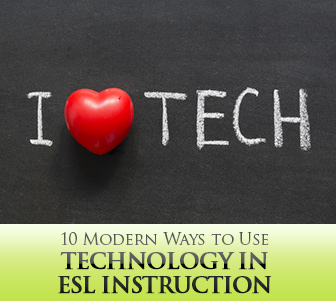High Tech Teaching: 8 Technologies You Should Be Using in Class


Computers, tablets and e-readers can all be instrumental in learning English, offering interactive and motivating activities for students of all ages. The following are 10 different ways that ESL teachers can use technology to teach English in a way that will make lessons more engaging and appealing:

Using short and feature-length videos is an engaging way to work on skills like vocabulary and comprehension. Videos help to expose students to the use of natural English. Young children really enjoy short cartoons and animated movies, and older students can learn about current events through news broadcasts.
ESL Partyland has free resources that include vocabulary worksheets and discussion questions to accompany films like ‘Bonnie and Clyde’, ‘Vertigo’ and ‘Dead Man Walking’. The site also offers a film survey to assess your students’ interests before choosing films, and film reviews that can be adapted for any level of instruction.
Learning English can be very difficult and frustrating at times. Apps on iPads and tablets are great ways for students to practice English and have fun while doing it. For practicing grammar rules, apps like Grammar Up allow students to test their knowledge on specific topics (verbs, prepositions, etc.). The app also keeps track of students’ progress and allows them to skip questions by shaking the tablet. Best Colleges Online offers a list of 16 apps for ESL students, ranging from basic letter instruction to pronunciation guides. Students can also play classic games like Scrabble and Boggle on mobile devices.
Students absorb a great deal of information through experiential learning, but field trips are not always an option with limited school budgets. Digital field trips provide more authentic ways for students to absorb new information. Young children can learn vocabulary through fun virtual trips via 4-H Virtual Farm, while older students can learn about the government on sites like Inside the White House. There are many options on the Internet to learn about virtually any topic. Middle School Net offers links to a wide array of digital field trip possibilities.
Students can listen to podcasts to improve their comprehension. They can also create podcasts to practice their English speaking abilities. A free download of iTunes gives teachers access to hundreds of free podcasts on a range of topics. There are multiple podcasts tailored specifically for English language learners. Teachers can also have students create podcasts to give them opportunities to practice their speaking skills. With just a microphone and a computer, students can create reports and presentations. Video podcasts are an attractive option for students, and some classes even have their own YouTube channels.
Since snail mail is becoming a thing of the past, students can have pen pals that they email or write to on a discussion board. Make an arrangement with an English-speaking class in another state or country and have students write to their pen pal on a regular basis. This is a great way for them to practice their English writing and reading comprehension skills, while making friends in the process. Connect your classroom for free today with ePals!
Web quests are a fun way for students to use the Internet to build English proficiency. Students are given a task and rely on their content knowledge and grasp of English language to complete it. Teachers can create their own or visit Web Quests to access tutorials and databases of pre-created web quests.
Students can master spelling, grammar and other English skills by playing games on the computer or mobile devices. Funbrain has educational games and books for Pre-K to eighth grade students. StarFall has multiple games for younger students to increase English literacy skills. Digital versions of hangman, Scrabble and Boggle are also entertaining for all ages of students. Many of these games can be put up on interactive white boards to get full class participation.
Class blogs provide great forums for students to practice their writing skills. Live Journal, Edublog and Blogger allow you to create blogs for free. One of the reasons that students find blogging appealing is that it is more of an authentic writing experience, as a wider audience typically has access to read posted entries, which means students tend to put more effort into their blogs. Teachers can get students to write about specific topics that they find interesting, or students can provide commentary on current events and social justice issues. The more they practice their writing skills, the more proficient they become, so regular blogging (weekly or daily) is recommended. Blogs also provide good opportunities for family members to see what their children are working on in class!
Skype is a great way for students to practice their speaking and listening skills with other people from any location. Teaching Degree offers 50 suggestions on how to use Skype in the classroom. Students can have question-and-answer sessions with authors of books, attend video-conferences and virtual field trips, interview professionals, and connect with students from other cultures and countries. Skype can even be used to conduct parent-teacher conferences or connect with students’ family members who may be abroad!
Dave's ESL Cafe has a page for students that provides easy-to-understand explanations of different grammar concepts, like tenses and verb forms. It also has an Idea Cookbook, which is full of resources for teachers to improve ESL instruction. Audio books can be used to supplement reading instruction and improve comprehension. Since technology is something that students interact with regularly outside of school and students need 21st century skills to be successful in college and their future careers, the more that technology can be integrated into instruction, the better.
This is a guest article by Sarah Fudin. Sarah currently works in community relations for the University of Southern California Rossier School of Education’s online Masters of Education programs, which provides current and aspiring teachers the opportunity to earn an Masters of Education or MAT online. Outside of work Sarah enjoys running, reading and Pinkberry frozen yogurt.